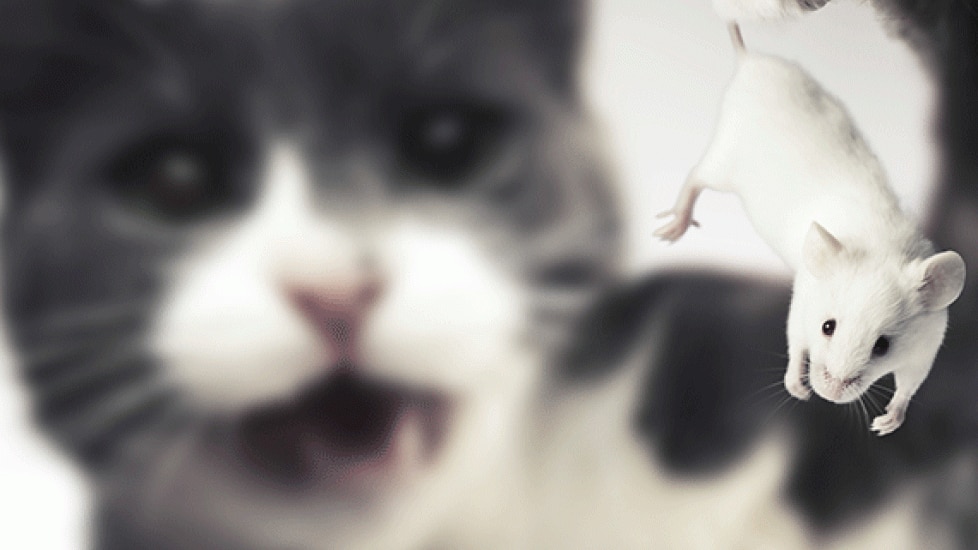Cat Food for “Real” Cats
I’ve been noticing a trend in the cat food aisle over the last few years. The diets on display are described in terms that you might find on the menu of the hot, new restaurant that just opened up down the block. Here are a few examples of what I’m talking about:
- Elegant Medleys Florentine, Primavera, and Tuscany
- Delectable Delights
- Gourmet Classics
- Tasty Treasures
- Prime Filets
- Grilled Feast
- Indigo Moon (huh?)
- Mixed Grill
- Purrfect Bistro
- Signature Selects
- Wild Delights
- Marinated Morsels
- Seafood Sensations
- Stew
- Healthy Indulgence
- Divine Duos
- Rise and Shine
- Gourmet Pate
- … and my personal favorite, Feline Health Nutrition Intense Beauty
Ingredient lists are not immune to this trend, either. This is an unedited ingredient list that I recently ran across. I’ve highlighted a few of the entries that made me do a double take.
Peas, Chicken, Ocean Fish Meal, Dried Eggs, Natural Flavors, Pea Protein, Choline Chloride, Potassium Chloride, Taurine, DL-Methionine, Salmon Oil (preserved with mixed Tocopherols), L-Carnitine, Dried Chicory Root, Carrots, Pumpkin, Apples, Cranberries, Blueberries, Broccoli, Parsley, Spearmint, Almond Oil (preserved with mixed Tocopherols), Sesame Oil (preserved with mixed Tocopherols), Yucca Schidigera Extract, Dried Kelp, Thyme, Lentils, Vitamin A Supplement, Vitamin D3 Supplement, Vitamin E Supplement, Zinc Sulfate, Niacin, Ferrous Sulfate, L-Ascorbyl-2-Polyphosphate (Source of Vitamin C), Calcium Pantothenate, Thiamine Mononitrate, Copper Sulfate, Riboflavin, Pyridoxine Hydrochloride, Manganese Sulfate, Zinc Proteinate, Folic Acid, Calcium Iodate, Manganese Proteinate, Copper Proteinate, Sodium Selenite, Biotin, Vitamin B12 Supplement, Rosemary Extract, Dried Lactobacillus Acidophilus Fermentation Product, Dried Enterococcus Faecium Fermentation Product, Dried Lactobacillus Casei Fermentation Product
I am fully aware that pet food marketing is aimed at owners and not pets, but I worry that we are starting to so anthropomorphize our companion animals that we now want them to eat like us.
Of course, including some apples and blueberries into a nutritionally complete cat food and naming it Fruit Stand Fritters or something equally goofy isn’t going to do any harm, but taken too far, this trend of feeding cats like people can be very dangerous. Remember a few years back when an Australian kitten nearly died after being fed a vegan diet consisting of potatoes, rice milk, and pasta?
I’m thinking about opening my own cat food company and going in the opposite direction. African wildcats, the most likely ancestor of today’s house cats, eat primarily mice, rats, and rabbits, with the occasional bird or reptile thrown in for good measure. Left to their own devices, feral cats tend to eat a similar diet. I think I’ll call my products Cat Food for “Real” Cats, and my ingredient lists will include things like:
- Whole Mouse
- Lizard Meal
- Rabbit Liver
- Wild Caught Songbird
My labels won’t include a picture of a perfectly groomed Persian nibbling on her Prime Filets served on a silver tray. I think I’ll use an image of a run-of-the mill Tabby standing over a partially eviscerated mouse instead.
What do you think? Do I have a best seller on my hands?
Dr. Jennifer Coates
